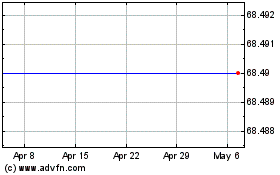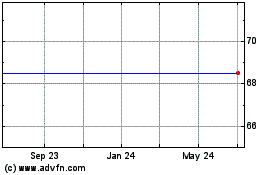-- PRO designed to
establish clinical benefit –
Global Blood Therapeutics, Inc. (GBT) (NASDAQ:GBT) today announced
that the methodology used to develop the Patient Reported Outcome
(PRO) tool that will be used as a secondary clinical endpoint in
the company’s planned pivotal Phase 3 clinical trial of GBT440 in
people with sickle cell disease (SCD), titled the HOPE
(
Hemoglobin
Oxygen Affinity
Modulation to Inhibit HbS
Polym
Erization) Study, was
presented at the 58th American Society of Hematology (ASH) Annual
Meeting & Exposition (abstract #4760). The nine-item Sickle
Cell Disease Severity Measure (SCDSM) has been designed by GBT to
assess the entire range of SCD symptoms, to distinguish between
good days and bad days based on symptoms and to measure all crisis
events regardless of health care utilization.
“Previous SCD studies have focused on vaso-occlusive crisis
(VOC) defined as a painful crisis requiring hospital or emergency
room utilization as the traditional clinical endpoint. However,
studies have shown that VOC is not a full measure of the burden of
SCD daily symptoms because many episodes of pain are managed at
home rather than in a doctor’s office, hospital or emergency room
and are thus under-reported. VOC is the tip of the iceberg,” said
Wally Smith, M.D., Florence Neal Cooper Smith Professor of Sickle
Cell Disease Director, and Director of the comprehensive sickle
cell program at Virginia Commonwealth University. “By
having this new electronic patient reported outcomes (PRO) tool, we
will be able to more reliably assess daily symptom severity, with a
single total symptom score, potentially allowing us to accelerate
the development of urgently needed new SCD therapies.”
PRO development used qualitative and quantitative analyses and
was undertaken in collaboration with SCD patient groups and
external experts, and with active engagement with the Clinical
Outcomes Assessment group of the United States Food and Drug
Administration (FDA). The instrument was designed with a specific
set of nine questions to produce a score to measure the full range
of daily SCD severity in adult and adolescent SCD patients. The
HOPE PRO includes questions specific to pain, energy level and
fatigue, concentration and breathlessness- the symptoms that
matters the most to patients with SCD. When qualified by following
FDA guidance, a PRO instrument can be used as a clinical endpoint
to establish benefit for regulatory approval. In the HOPE Study,
the HOPE PRO instrument will be administered on a hand-held
electronic device and will explore the clinical benefit of GBT440
in SCD. It is designed to distinguish between good days and bad
days based on symptoms, which should be sensitive to all pain
crises, with or without healthcare utilization. The PRO will also
be able to assess an improvement in symptoms from baseline, such as
improved fatigue. During Part A of the HOPE Study, the PRO
instrument will quantify the magnitude of changes in daily total
symptom scores over three months. The HOPE PRO complies with the
FDA’s issued guidance for PRO development.
“We are excited to have developed, in conjunction with the SCD
community, the first PRO for SCD suitable for use as a clinical
endpoint that could support potential FDA approval of a drug for
the treatment of SCD. The HOPE PRO is designed to be a reliable,
valid and sensitive measurement that meets regulatory requirements
as a clinical outcome assessment tool, is easy for patients to use,
and will generate scores that are clinically meaningful,” said Ted
W. Love, M.D., president and chief executive officer of GBT. “With
the utilization of the HOPE PRO, our highly innovative HOPE Study
trial design will allow us to measure the core symptoms of SCD that
matter most to patients - pain and fatigue - as well as other key
SCD symptoms.”
Also presented at ASH yesterday were data from the ongoing Phase
1/2 GBT440-001 study that further support the safety and efficacy
profile of GBT440 as a potentially disease-modifying therapy for
sickle cell disease (SCD) and results showing how GBT440 is
metabolized in healthy subjects.
Investor Event Webcast DetailsToday, Monday,
December 5, at 12:15 p.m. PT, members of GBT’s management team and
Jo Howard, MB BChir, MRCP, FRCPath, of Guy’s and St Thomas’ NHS
Foundation Trust, Wally R. Smith, MD of Virginia Commonwealth
University, and Jeremy Hobart, BSc PhD FRCP Dip Public Health, of
Peninsula Schools of Medicine and Dentistry will review GBT440 ASH
data presentations. The event will be webcast live and will be
available for replay from the Investors section of GBT’s website at
www.globalbloodtx.com for 30 days.
About GBT440 in Sickle Cell DiseaseGBT440 is
being developed as an oral, once-daily therapy for patients with
SCD. GBT440 works by increasing hemoglobin's affinity for oxygen.
Since oxygenated sickle hemoglobin does not polymerize, GBT
believes GBT440 blocks polymerization and the resultant sickling of
red blood cells. With the potential to restore normal hemoglobin
function and improve oxygen delivery, GBT believes that GBT440 may
dramatically modify the course of SCD.
In recognition of the critical need for new SCD treatments, the
U.S. Food and Drug Administration (FDA) has granted GBT440 both
fast track and orphan drug designations and the European Commission
(EC) has designated GBT440 as an orphan medicinal product for the
treatment of patients with SCD. In addition to the ongoing Phase
1/2 GBT440-001 trial, GBT440 is being evaluated in an open-label,
single and multiple dose study in adolescents (age 12 to 17) with
SCD. This study is assessing the safety, tolerability,
pharmacokinetics and exploratory treatment effect of GBT440.
Additionally, GBT440 will be evaluated in the pivotal Phase 3
HOPE Study. This randomized, double-blind, placebo-controlled,
multi-national trial will enroll up to 400 patients age 12 and
older with SCD who have had at least one episode of vaso-occlusive
crisis (VOC) in the previous year. The study will be conducted in
two parts: Part A will compare GBT440 administered at doses of 900
or 1,500 mg per day vs. placebo in up to 150 patients treated for
at least 12 weeks, and Part B will include 250 patients randomized
to placebo or a dose of GBT440 based on Part A. The main objectives
of Part A are to select the optimal dose, define the final
secondary endpoints for Part B, and qualify the PRO instrument. The
primary efficacy endpoint of the HOPE Study is the proportion of
patients who achieve a greater than 1 g/dL increase in hemoglobin
at 24 weeks of treatment compared with baseline. Key secondary
efficacy endpoints include the effect of GBT440 on SCD symptom
exacerbation (as measured by the HOPE PRO instrument), overall SCD
symptoms, traditionally defined VOCs, hospitalizations and red
blood cell transfusions.
About Sickle Cell Disease (SCD)SCD is a
lifelong inherited blood disorder caused by a genetic mutation in
the beta-chain of hemoglobin, leading to formation of abnormal
hemoglobin known as sickle hemoglobin, or HbS. In its deoxygenated
state, HbS has a propensity to polymerize, or bind together forming
long, rigid rods within a red blood cell (RBC). The polymer rods
deform RBCs to assume a sickled shape and to become inflexible,
which can cause blockage in small blood vessels. Beginning in
childhood, SCD patients suffer unpredictable and recurrent episodes
or crises of severe pain due to blocked blood flow to organs, which
often lead to psychosocial and physical disabilities. This blocked
blood flow, combined with hemolytic anemia (the destruction of
RBCs), can eventually lead to multi-organ damage and early
death.
About Global Blood TherapeuticsGlobal Blood
Therapeutics, Inc. is a clinical-stage biopharmaceutical company
dedicated to discovering, developing and commercializing novel
therapeutics to treat grievous blood-based disorders with
significant unmet need. GBT is developing its lead product
candidate, GBT440, as an oral, once-daily therapy for sickle cell
disease and will initiate its Phase 3 clinical trial by the end of
2016. GBT is also investigating GBT440 for the treatment of
hypoxemic pulmonary disorders in two ongoing Phase 2a studies in
patients with idiopathic pulmonary fibrosis. To learn more, please
visit: www.globalbloodtx.com.
Forward-Looking Statements Statements we make
in this press release may include statements that are not
historical facts and are considered forward-looking within the
meaning of Section 27A of the Securities Act of 1933, as amended
and Section 21E of the Securities Exchange Act of 1934, as amended.
We intend these forward-looking statements, including statements
regarding the therapeutic potential and safety profile of GBT440,
our ability to implement our clinical development plans for GBT440,
the timing of, and our ability to generate data from, our ongoing
Phase 1/2 clinical trial of GBT440 and our ability to begin and
generate data from our HOPE Study, and regarding the use of the PRO
in our HOPE Study, to be covered by the safe harbor provisions for
forward-looking statements contained in Section 27A of the
Securities Act and Section 21E of the Securities Exchange Act and
are making this statement for purposes of complying with those safe
harbor provisions. These forward-looking statements reflect our
current views about our plans, intentions, expectations, strategies
and prospects, which are based on the information currently
available to us and on assumptions we have made. We can give no
assurance that the plans, intentions, expectations or strategies
will be attained or achieved, and furthermore, actual results may
differ materially from those described in the forward-looking
statements and will be affected by a variety of risks and factors
that are beyond our control including, without limitation, the
risks that our clinical and preclinical development activities may
be delayed or terminated for a variety of reasons, that regulatory
authorities may disagree with our clinical development plans or
require additional studies or data to support further clinical
investigation of our product candidates, and that drug-related
adverse events may be observed in later stages of clinical
development, along with those risks set forth in our Annual Report
on Form 10-K for the fiscal year ended December 31, 2015, and in
our Quarterly Reports on Form 10-Q for the quarters ended March 31,
2016, June 30, 2016 and September 30, 2016, as well as discussions
of potential risks, uncertainties and other important factors in
our subsequent filings with the U.S. Securities and Exchange
Commission. Except as required by law, we assume no obligation to
update publicly any forward-looking statements, whether as a result
of new information, future events or otherwise.
Contact Information:
Myesha Lacy (investors)
Global Blood Therapeutics
650-351-4730
investor@globalbloodtx.com
Julie Normart (media)
BrewLife
415-946-1087
media@globalbloodtx.com
Global Blood Therapeutics (NASDAQ:GBT)
Historical Stock Chart
From Mar 2024 to Apr 2024

Global Blood Therapeutics (NASDAQ:GBT)
Historical Stock Chart
From Apr 2023 to Apr 2024
